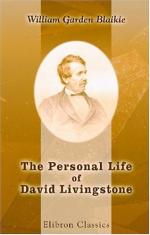It was the accursed slave-trade, promoted by the Portuguese, that had frustrated everything. For some time to come his efforts and his prayers must be directed to getting influential men to see to this, so that one way or other the trade might be abolished forever. The hope of obtaining access to the heart of Africa by another route than that through the Portuguese settlements was still in Livingstone’s heart. He would go home, but only for a few months; at the earliest possible moment he would return to look for a new route to the interior.
CHAPTER XVI.
QUILIMANE TO BOMBAY AND ENGLAND.
A.D. 1864.
Livingstone returns the “Pioneer” to the Navy, and is to sail in the “Nyassa” to Bombay—Terrific circular storm—Imminent peril of the “Nyassa”—He reaches Mozambique—Letter to his daughter—Proceeds to Zanzibar—His engineer leaves him—Scanty crew of “Nyassa”—Livingstone captain and engineer—Peril of the voyage of 2500 miles—Risk of the monsoons—The “Nyassa” becalmed—Illness of the men—Remarks on African travel—Flying-fish—Dolphins—Curiosities of his Journal—Idea of a colony—Furious squall—Two sea-serpents seen—More squalls—The “Nyassa” enters Bombay harbor—Is unnoticed—First visit from officers with Custom-house schedules—How filled up—Attention of Sir Bartle Frere and others—Livingstone goes with the Governor to Dapuri—His feelings on landing in India—Letter to Sir Thomas Maclear—He visits mission-schools, etc., at Poonah—Slaving in Persian Gulf—Returns to Bombay—Leaves two boys with Dr. Wilson—Borrows passage-money and sails for England—At Aden—At Alexandria—Reaches Charing Cross—Encouragement derived from his Bombay visit—Two projects contemplated on his way home.
On reaching the mouth of the Zambesi, Dr. Livingstone was fortunate in falling in, on the 13th February, with H.M.S. “Orestes,” which was joined on the 14th by the “Ariel.” The “Orestes” took the “Pioneer” in tow, and the “Ariel” the “Lady Nyassa,” and brought them to Mozambique. The day after they set out, a circular storm passed over them, raging with the utmost fury, and creating the greatest danger. Often as Dr. Livingstone had been near the gates of death, he was never nearer than now. He had been offered a passage on board the “Ariel,” but while there was danger he would not leave the “Lady Nyassa.” Had the latter not been an excellent sea-ship she could not have survived the tempest; all the greater was Dr. Livingstone’s grief that she had never reached the lake for which she was adapted so well.
Writing to his daughter Agnes from Mozambique, he gives a very graphic account of the storm, after telling her the manner of their leaving the Zambesi:




